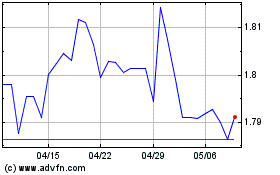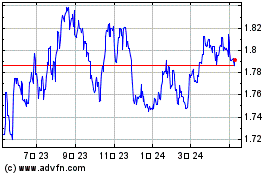Australian, NZ Dollars Advance Amid Rising Risk Appetite
2018年6月12日 - 12:18PM
RTTF2
The Australian and NZ dollars firmed against their major
opponents in the Asian session on Tuesday amid rising risk
appetite, as a highly anticipated U.S.-Korea summit got underway in
Singapore.
Analysts expect no major breakthroughs from the meeting even as
both leaders face considerable pressure to pull off a success after
an elevation in geopolitical tensions last year.
Secretary of State Mike Pompeo indicated on Monday the U.S. is
prepared to offer North Korea "unique" security assurances in
exchange for the complete, verifiable and irreversible
denuclearization of the Korean peninsula.
Investors also await monetary policy announcements by three
major central banks due this week.
The Federal Reserve is widely expected to raise interest rates
by 25 basis points when it meets Tuesday and Wednesday.
The European Central Bank has already indicated that its
upcoming meeting on Thursday will be used to discuss ending its
bond purchasing program.
Survey data from the National Australia Bank showed that
Australia's business conditions and confidence weakened notably in
May.
The business confidence index fell to 6.0 in May from 11.0 in
the previous month.
Figures from the Australian Bureau of Statistics showed that the
total number of owner occupied housing commitments in Australia
decreased for the fifth straight month in April.
On a seasonally adjusted basis, total number of owner occupied
dwelling commitments dropped 1.4 percent month-over-month in April,
slower than March's 2.3 percent fall.
The aussie advanced to a session's high of 0.7622 against the
greenback, after having fallen to a 4-day low of 0.7584 at 9:00 pm
ET. If the aussie rises further, it may find resistance around the
0.78 level.
The aussie hit a 5-day high of 84.16 against the yen from
yesterday's closing value of 83.72. On the upside, 86.00 is
possibly seen as the next resistance level for the aussie.
Data from the Ministry of Economy, Trade and Industry showed
that Japan's tertiary activity index increased in April after
falling in the previous month.
The tertiary activity index climbed 1.4 percent month-over-month
in April, reversing a 0.3 percent decrease in March.
The aussie spiked up to a 5-day high of 1.5443 against the euro
before holding steady in later deals. At yesterday's close, the
pair was worth 1.5482.
The kiwi climbed to 0.7046 against the greenback and 1.0811
against the aussie, from its early weekly low of 0.6998 and a 4-day
low of 1.0842, respectively. The kiwi is seen finding resistance
around 0.72 against the greenback and 1.07 against the aussie.
The kiwi strengthened to a 6-day high of 1.6705 against the euro
and near a 2-month high of 77.80 against the yen, reversing from
its early lows of 1.6785 and 77.19, respectively. The next possible
resistance for the kiwi is seen around 1.65 against the euro and
79.00 against the yen.
Looking ahead, U.K. jobless rate for the three months ended
April and German ZEW economic sentiment for June are due in the
European session.
In the New York session, U.S. CPI and monthly budget statement
for May are scheduled for release.
Euro vs NZD (FX:EURNZD)
FXチャート
から 3 2024 まで 4 2024

Euro vs NZD (FX:EURNZD)
FXチャート
から 4 2023 まで 4 2024
